CLICK THE IMAGE FOR A PEEK INSIDE DOSHI’S PRIVATE SHIBORI ART STUDIO
The Shibori Process
Shibori describes a variety of techniques of embellishing textiles by shaping cloth and securing it before dyeing. The word comes from the Japanese verb root shiboru: “to wring, squeeze, press.” The techniques include numerous resist processes practiced throughout the world. Shibori creates a three-dimensional form in the fabric by folding, stitching, pleating and twisting. The shaped cloth is then secured and dyed.
The beauty of shibori resist is it’s soft or blurry-edged pattern. An element of the unexpected is always present. The variables of shaping the cloth and all the elements that control the dye pot conspire to remove some of the shibori process from human control. Chance and accident give excitement and life to the shibori process. This is its special magic and strongest appeal for me as an artist.
Arashi (Pole Wrapping)
Resist-dye patterns are created by wrapping cloth around a pole, compressing it into folds, and dyeing it. Variations are achieved by wrapping in different directions, varying the distance between wraps, and different pole diameters.
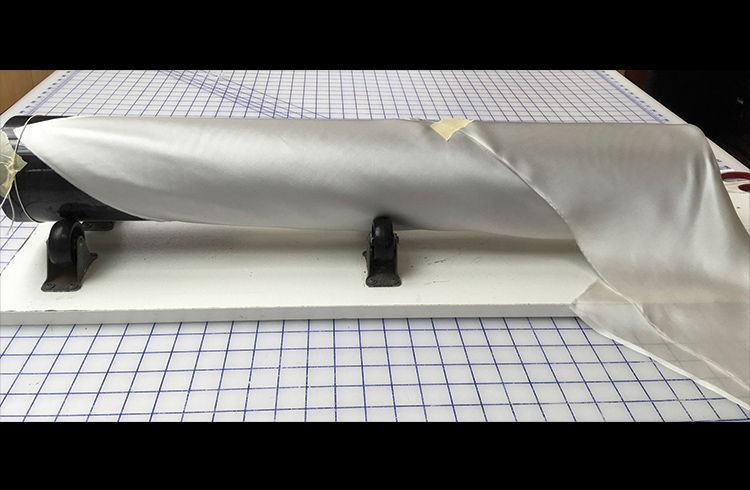
Resist-dye patterns are created by wrapping cloth around a pole, compressing it into folds, and dyeing it. Variations are achieved by wrapping in different directions, varying the distance between wraps, and different pole diameters.
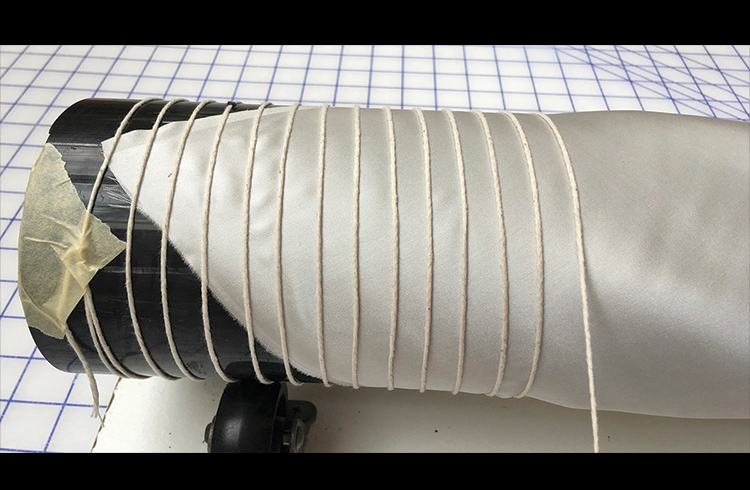
Cloth is wrapped on the diagonal around a cylinder and secured with tape. Thread is secured and then wrapped around cloth with controlled tension to hold it to the cylinder.
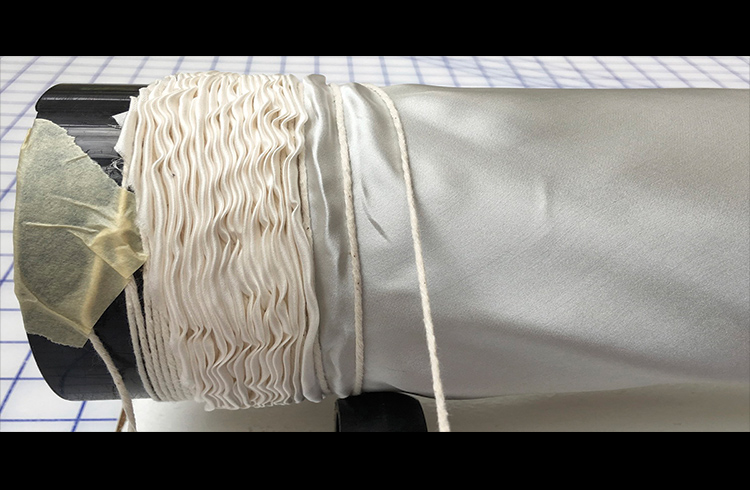
After wrapping for 4”- 6” the cloth is pushed to top of cylinder. All cloth is compressed and thread is secured below the fabric with a slip knot.
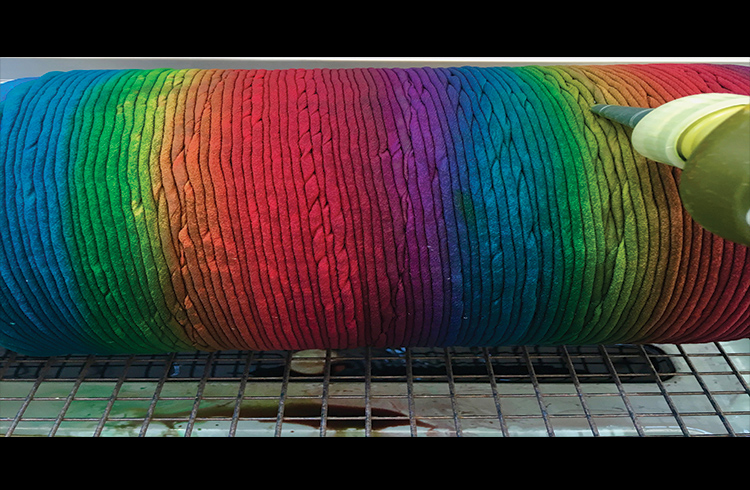
Dye is applied by pouring, painting, or dipping into a vat.
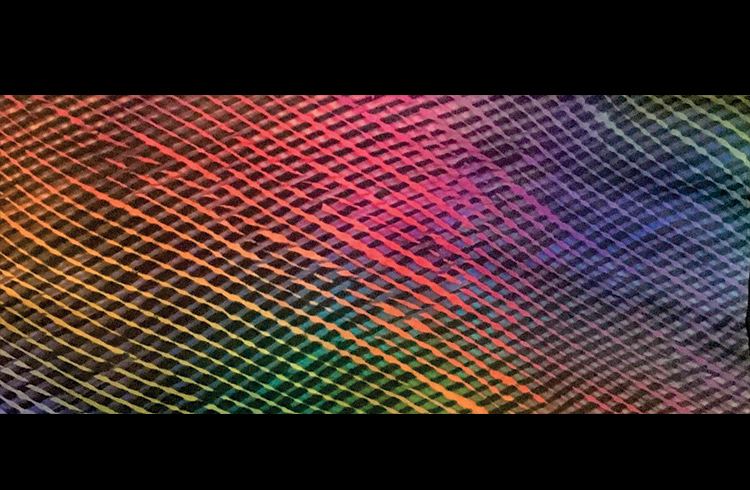
Black cloth is wrapped on the diagonal, discharged, and ombre dyed. The cloth is dried, then wrapped on the opposite diagonal. The same process of discharge and ombre dyeing is completed on the second wrap.
Tesuji (Pleating Over Flexible Core)
The cloth is hand-pleated over a rope core for the length of the fabric. Then, the pleated cloth is stretched between stands that hold the rope taut. The artist moves along the cloth with a string to bind it tightly at quarter-inch intervals. After dying the string is removed to reveal the dye and the resisted fabric under the pleats.
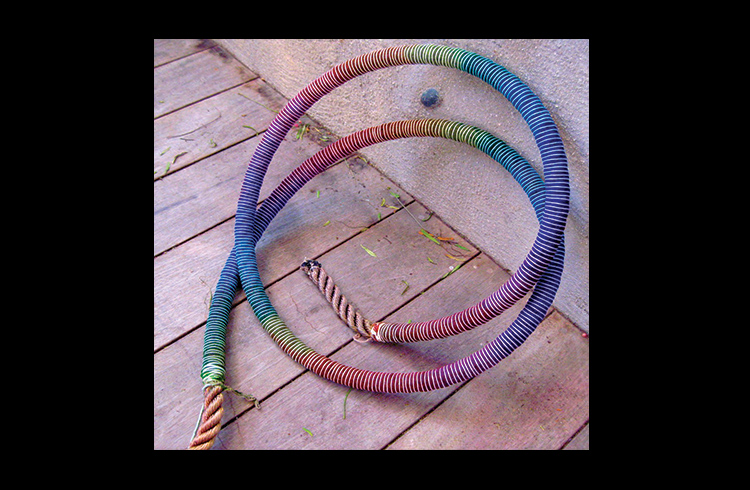
Fabric is pleated around rope core and string is used to bind it to the rope.
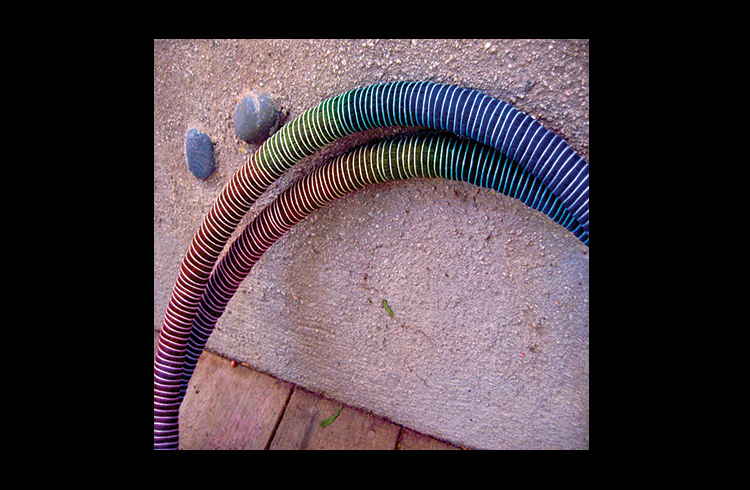
Detail of bound rope.
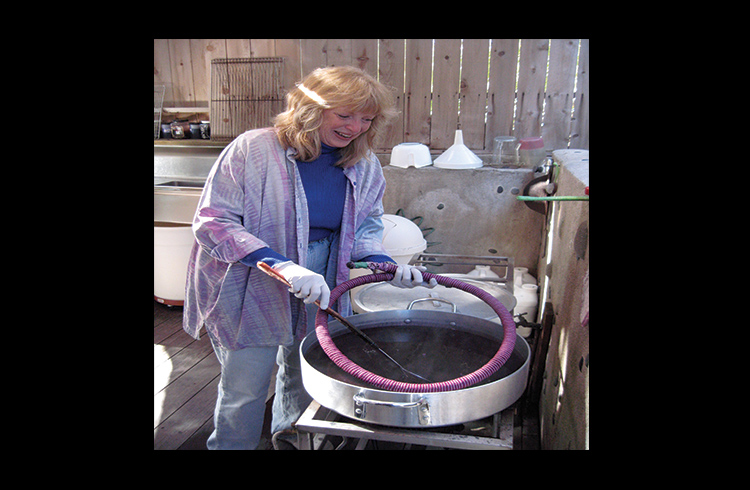
The tied rope is entered into a dye bath to apply the final color.
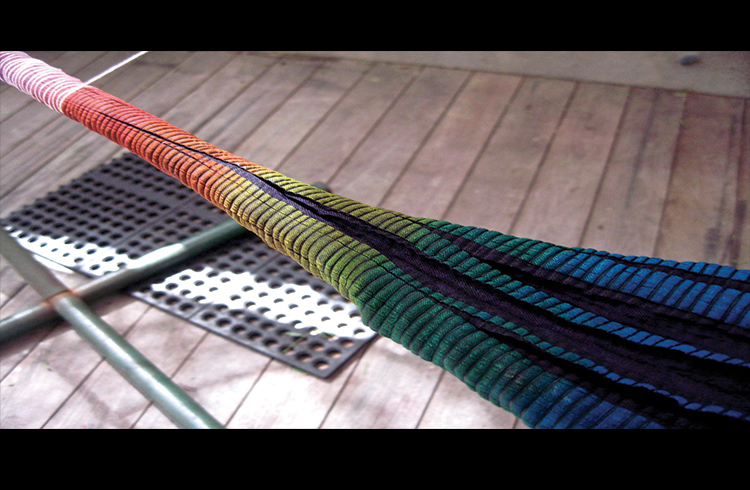
Unwrapping the string reveals the resisted fabric.
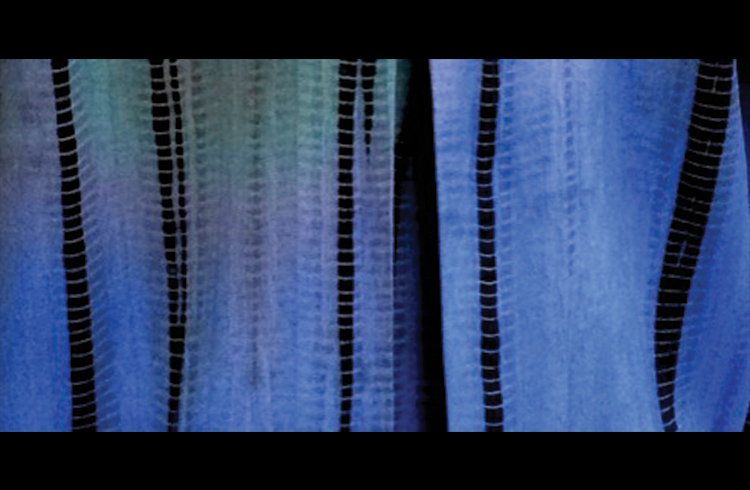
Finished fabric.
Nui (Stitch Resist)
The effects possible are created by the type of stitch, folding of the cloth, and the arrangement of the stitches. The cloth is drawn into tight gathers along the stitched threads, and secured.
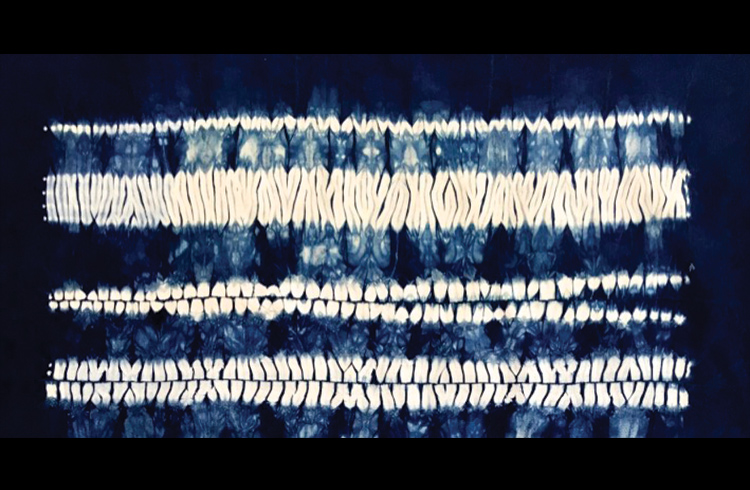
Row 1 – Nui
Row 2 – Mokume: Parallel rows of Nui
Row 3 & 4 – Ori-nui: Stitching through folded cloth, changing the distance of the stitch from the fold
Row 2 – Mokume: Parallel rows of Nui
Row 3 & 4 – Ori-nui: Stitching through folded cloth, changing the distance of the stitch from the fold
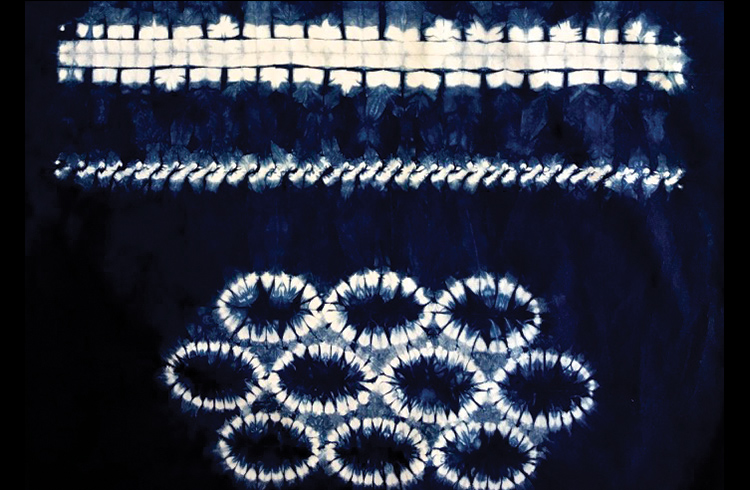
Row 1 – Ori-nui: Stitching through pleated cloth (3 layers)
Row 2 – Maki-nui: Stitching over a fold
Row 3 – Hishaki-nui: Stitching curves on a fold
Row 2 – Maki-nui: Stitching over a fold
Row 3 – Hishaki-nui: Stitching curves on a fold

Ori-nui: Parallel rows stitched through three layers of cloth
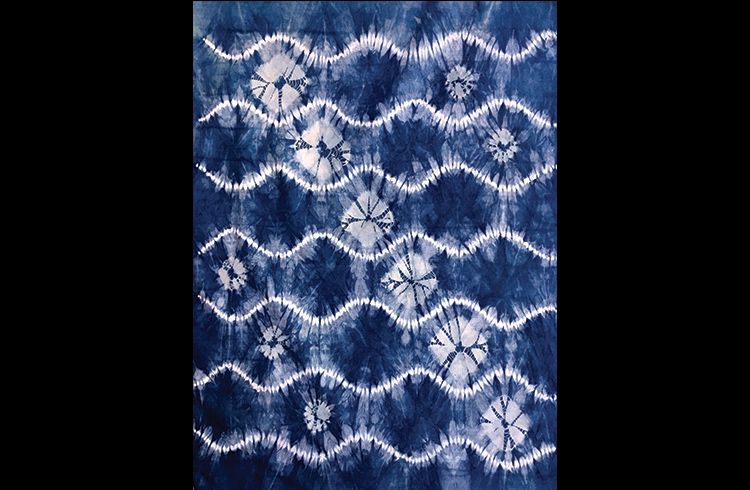
Hira Nui: with bound Kumo
Suji (Pleating)
The cloth is hand-pleated vertically along the length. A string winds around the hand-pleated fabric to maintain the pleat pattern. The peaks of each pleat are exposed to the dye, resulting in vertically
striped patterns.
Itajime (Folding & Clamping)
Cloth is folded and then sandwiched between two pieces of wood or acrylic, held in place with string or clamps. The shapes prevent the dye from penetrating the fabric they cover.
CLICK THE IMAGE FOR A PEEK INSIDE DOSHI’S PRIVATE SHIBORI ART STUDIO
The Shibori Process
Shibori describes a variety of techniques of embellishing textiles by shaping cloth and securing it before dyeing. The word comes from the Japanese verb root shiboru: “to wring, squeeze, press.” The techniques include numerous resist processes practiced throughout the world. Shibori creates a three-dimensional form in the fabric by folding, stitching, pleating and twisting. The shaped cloth is then secured and dyed.
The beauty of shibori resist is it’s soft or blurry-edged pattern. An element of the unexpected is always present. The variables of shaping the cloth and all the elements that control the dye pot conspire to remove some of the shibori process from human control. Chance and accident give excitement and life to the shibori process. This is its special magic and strongest appeal for me as an artist.
Arashi (Pole Wrapping)
Resist-dye patterns are created by wrapping cloth around a pole, compressing it into folds, and dyeing it. Variations are achieved by wrapping in different directions, varying the distance between wraps, and different pole diameters.

Resist-dye patterns are created by wrapping cloth around a pole, compressing it into folds, and dyeing it. Variations are achieved by wrapping in different directions, varying the distance between wraps, and different pole diameters.

Cloth is wrapped on the diagonal around a cylinder and secured with tape. Thread is secured and then wrapped around cloth with controlled tension to hold it to the cylinder.

After wrapping for 4”- 6” the cloth is pushed to top of cylinder. All cloth is compressed and thread is secured below the fabric with a slip knot.

Dye is applied by pouring, painting, or dipping into a vat.

Black cloth is wrapped on the diagonal, discharged, and ombre dyed. The cloth is dried, then wrapped on the opposite diagonal. The same process of discharge and ombre dyeing is completed on the second wrap.
Tesuji (Pleating Over Flexible Core)
The cloth is hand-pleated over a rope core for the length of the fabric. Then, the pleated cloth is stretched between stands that hold the rope taut. The artist moves along the cloth with a string to bind it tightly at quarter-inch intervals. After dying the string is removed to reveal the dye and the resisted fabric under the pleats.

Fabric is pleated around rope core and string is used to bind it to the rope.

Detail of bound rope.

The tied rope is entered into a dye bath to apply the final color.

Unwrapping the string reveals the resisted fabric.

Finished fabric.
Nui (Stitch Resist)
The effects possible are created by the type of stitch, folding of the cloth, and the arrangement of the stitches. The cloth is drawn into tight gathers along the stitched threads, and secured.

Row 1 – Nui
Row 2 – Mokume: Parallel rows of Nui
Row 3 & 4 – Ori-nui: Stitching through folded cloth, changing the distance of the stitch from the fold
Row 2 – Mokume: Parallel rows of Nui
Row 3 & 4 – Ori-nui: Stitching through folded cloth, changing the distance of the stitch from the fold

Row 1 – Ori-nui: Stitching through pleated cloth (3 layers)
Row 2 – Maki-nui: Stitching over a fold
Row 3 – Hishaki-nui: Stitching curves on a fold
Row 2 – Maki-nui: Stitching over a fold
Row 3 – Hishaki-nui: Stitching curves on a fold

Ori-nui: Parallel rows stitched through three layers of cloth

Hira Nui: with bound Kumo
Suji (Pleating)
The cloth is hand-pleated vertically along the length. A string winds around the hand-pleated fabric to maintain the pleat pattern. The peaks of each pleat are exposed to the dye, resulting in vertically
striped patterns.
Itajime (Folding & Clamping)
Cloth is folded and then sandwiched between two pieces of wood or acrylic, held in place with string or clamps. The shapes prevent the dye from penetrating the fabric they cover.
